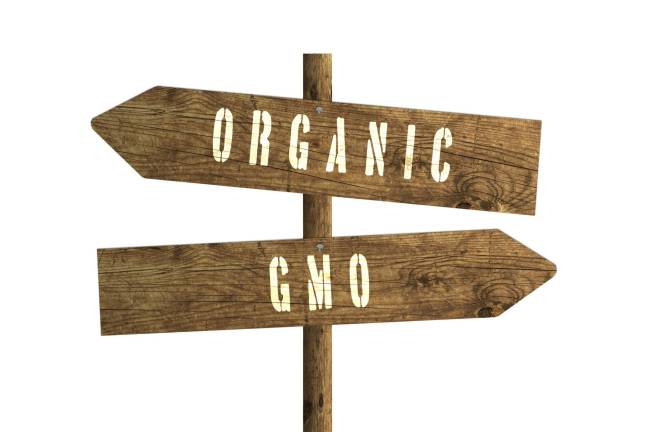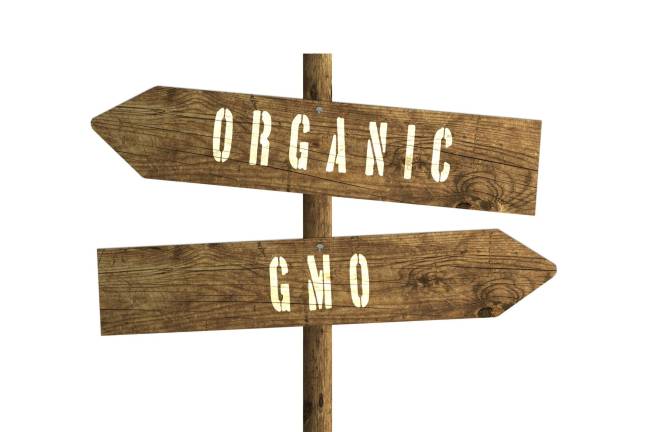GMOs: Indispensible or foolhardy?


Eight new crops; one persistent misconception I asked a friend’s wife what she thought a GMO was, and she said, “anything that is not of its original state.” By that definition everything is a genetically modified organism. If one plant breeds with another, the genetics intertwine and change the genetic profile of the seed. Our ancestors would save seed from certain plants because they had higher yields or more fruit or better disease resistance, changing the genetics of the plants. The irony is that this friend got a new puppy: a Labradoodle. The other day, I was at QuickChek getting a cup of coffee when I noticed their advertisement for “non GMO chicken.” What does that mean? Are the chickens non GMO? Are the chickens not fed GMOs? If the chickens are non GMO, I would consider that false advertising since no chicken is a GMO. This goes along the lines of “organic maple syrup.” When was the last time you saw someone spraying the sugar bush with pesticides? Which is all to say, beware the adman. The first GMO was created in 1972 when scientists combined a monkey virus and a bacteria virus. The first GMO crop was approved by China in 1992. Currently in the U.S. there are eight GMO crops: soybeans, corn, papaya, canola, cotton, alfalfa, sugar beets and summer squash. In the crop world, GMOs are created by splicing a gene from one thing and inserting it into a crop, making the crop resistant to something. Summer squash becomes resistant to cucumber mosaic virus, zucchini to yellow virus. Soybeans and corn resist Roundup applications. Roundup has dominated the conversation about GMOs in the public sphere, where the belief has taken hold that GMOs lead to more pesticides. I don’t see how that is possible. Take Bt corn. Years ago, corn was sprayed with an insecticide to prevent corn borers from damaging the plants. Now the plant resists the corn borer through genetics, allowing for less pesticides. Look at the summer squash. Resistance to cucumber mosaic virus is bred into it so a producer does not need to spray for this virus. There are thousands of crops not yet released to be grown that have higher vitamin contents, longer shelf life or other benefits. The question we are all invested in answering is: How do we intend to feed the world? Some researchers have determined that without increased crop yields, with today’s population growth, we will not produce enough food by the year 2050. Mat Cooper is an agronomist for Crop Production Services, Pine Island, NY Why risk it? (Remember DDT?) GMOs sometimes seem promising. Golden Rice comes to mind: a genetically modified rice that provides children, whose sustenance relies on rice, with essential vitamin A. Seems lovely. But then I think, “Just vitamin A? What kind of vitamin A? Is there enough fat in these kids’ diets to metabolize the vitamin A?” Aren’t there other ways to provide children with appropriate vitamins? Sure, but they can’t be patented and won’t make millions. GMOs are supposed to be the key to feeding the world. They are supposed to decrease pesticide and herbicide use, which is important for human health and for the earth. But the most recent studies show no discernible gains in yield. And the U.S. Geological Survey reports that while there is a slight decrease in pesticide use, herbicide use has increased at least 21 percent, more in GMO crops. Meanwhile, France has successfully decreased pesticides 65 percent and herbicides 36 percent using traditional means. So there are other ways. Companies view research saying GMOs are dangerous as attacks on their bottom lines. The landscape is wrought with accusations and cover-ups. I don’t need current studies when deciding about GMOs. I practice the precautionary principle, waiting until something new is proven safe before integrating it into my diet. I’m concerned the new forms of nutrients in GMO food aren’t recognizable and metabolizable by our bodies. I also worry that increased use of herbicides, which GMOs seem to perpetrate, will prove particularly unhealthy. Remember DDT was deemed safe and useful until enough time passed for people to see how harmful it was. It will take a while for GMOs to be considered unsafe. I worry that GMOs will have a detrimental effect on the environment, too. If we worked at developing classic and organic methods, we would find much more effective, safe, dependable ways to boost production and reduce chemicals. There are recent archaeological findings of huge populations in South America which were supported by rather small agricultural fields for thousands of years without soil depletion. I tend to be particularly skeptical when a study makes one side a lot of money. I have often been the one person in a room saying something isn’t safe, like antibacterial soap or margarine, and eventually I end up proven right. So I eat mostly organic, supporting the system that will support the earth long term. Barbara Laino is farmer/owner of Midsummer Farm, Warwick, NY